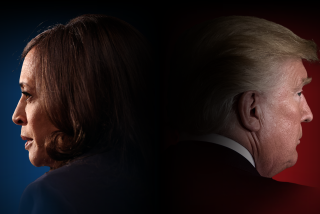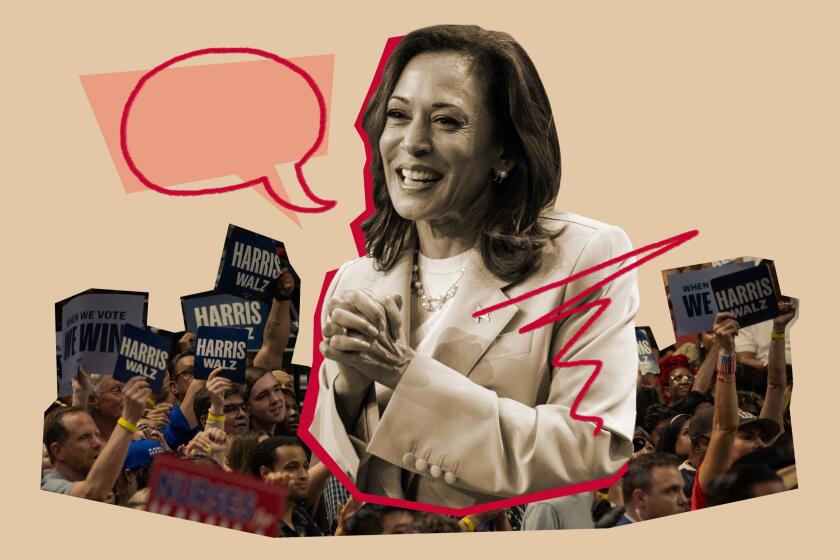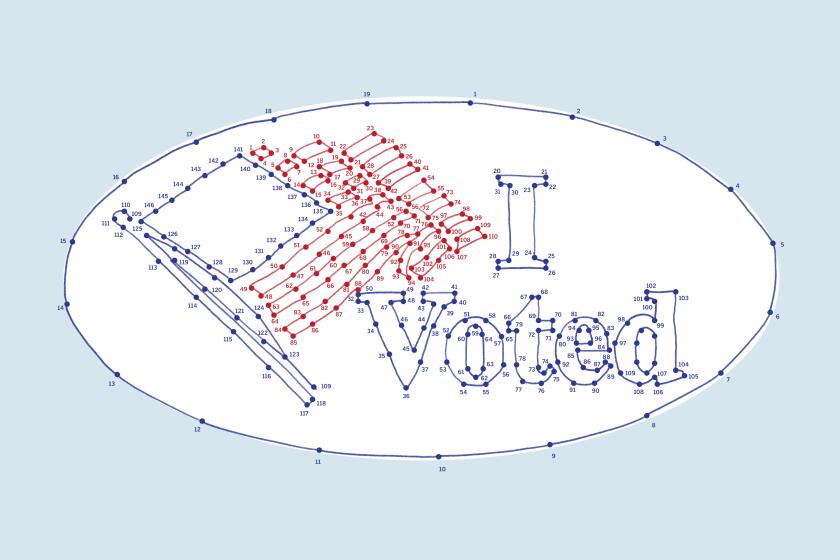Bush says security gains permit ‘surge’ pullback
WASHINGTON — President Bush said Thursday night that improved security in Iraq would allow him to start bringing troops home, endorsing a proposed pullout that congressional critics in both parties have dismissed as too slow and too limited.
Adopting the proposal laid out by Army Gen. David H. Petraeus, the top U.S. commander in Iraq, Bush plans to begin withdrawing the additional combat troops he sent over the last eight months. Pentagon officials said at least 21,500 troops would come home, which could leave more American military personnel in the war zone than when the president began his buildup.
Bush said the “surge” had prepared Iraq to end sectarian violence by helping Iraqis feel safe and encouraging them to turn against militants. “Our success in meeting these objectives now allows us to begin bringing some of our troops home,” he said.
Speaking to the nation from the Oval Office, the president emphasized that the U.S. role in Iraq would last “beyond my presidency.”
“The success of a free Iraq is critical to the security of the United States,” Bush said in the 17-minute address. “Realizing this vision will be difficult -- but it is achievable. Our military commanders believe we can succeed. Our diplomats believe we can succeed. And for the safety of future generations of Americans, we must succeed.”
Bush’s address came during a week of intense Washington focus on Iraq. It began with Petraeus and Ryan Crocker, U.S. ambassador to Iraq, reporting to Congress, and it will conclude today with the administration’s latest report on the results of the troop buildup and on the political conditions in Iraq.
The report, ordered by Congress, is expected to present a pessimistic assessment of the Iraqi government’s ability to make rapid progress toward broad reconciliation.
Next week, the Senate will debate a defense authorization bill -- and Majority Leader Harry Reid (D-Nev.) has said Democrats will consider as many as half a dozen proposals designed to challenge Bush’s management of the war. Bush’s Iraq policies also face increasing opposition from moderate Senate Republicans.
With his speech, presented at what the administration sees as a key moment in the war, the president hopes to fend off these renewed efforts to limit his ability to deploy troops in Iraq.
Bush urged the Democratic-led Congress on Thursday to back his deployment plan, as Democrats have reached out to Republicans in recent days to support their plans. He said that those who saw success in Iraq as crucial to American security and those who wanted to bring the troops home “have been at odds.” Now, he said, it is possible “for people who have been on opposite sides of this difficult debate to come together.”
Congressional Democrats, who have criticized Petraeus’ recommended troop drawdown as inadequate, leveled the same charge against the president Thursday.
Sen. Jack Reed (D-R.I.), a former Army paratrooper, said that the United States was “eager for change in Iraq” and that Bush “failed to provide either a plan to successfully end the war or a convincing rationale to continue it.”
He said the president had given the troops neither a clear nor achievable mission, and that “an endless and unlimited military presence in Iraq is not an option.”
Sen. Olympia J. Snowe of Maine, one of four Senate Republicans who have backed a withdrawal timeline, strongly criticized Bush. “When the president asks to buy more time, the question is, more time for what?” she said. “Rather, the administration should acknowledge that we are at the point where significant and certain change in our Iraqi strategy is required.”
House Minority Leader John A. Boehner (R-Ohio), one of Bush’s most loyal allies, challenged his colleagues to stand by the president. “As we look forward to our next steps in Iraq, Congress is faced with a stark choice,” he said. “Either rally behind the proven, responsible strategy set forth by Gen. Petraeus and bring our troops home after victory, or demand an irresponsible, precipitous withdrawal that will force our troops to leave in defeat.”
Although Bush said he planned to bring troops home, he did not specify how many.
Pentagon officials said the number was at least 21,500 -- short of the 30,000 combat and support troops in the “surge.” The president said that the initial drawdown would bring 5,700 troops home by Christmas, and that by July, the 20 Army combat brigades would be reduced to 15. A brigade has about 3,500 soldiers.
Iraqi national security advisor Mowaffak Rubaie said this week that if Iraq’s forces were sufficiently prepared and security threats were down, the number of foreign troops there could fall below 100,000 by the end of 2008.
When Bush announced the buildup, 132,000 U.S. troops were stationed in Iraq. That number has grown to 169,000 today, the highest since the war began, and with overlap during turnover periods it is expected to reach 171,000 this fall.
Administration officials would not speculate on additional troop withdrawals. “Don’t overdrive your headlights” was how one White House official put it.
As he has through 4 1/2 years of war, Bush drew on the symbols of the presidency -- in this case the formal setting of the Oval Office and a prime-time televised address -- to try to sway public opinion. The last time the president addressed the nation from the Oval Office was a year ago, on the fifth anniversary of the Sept. 11 attacks.
The president at that time said Iraq was “fighting for its survival” and had placed its trust in the United States. “Our moral and strategic imperatives are one: We must help Iraq defeat those who threaten its future -- and also threaten ours,” he said.
Bush on Thursday continued to cast Iraq as the central front in the fight against terrorism: “Terrorists and extremists who are at war with us around the world are seeking to topple Iraq’s government, dominate the region and attack us here at home.”
He was more nuanced in this speech, making no mention of Osama bin Laden and drawing no link to the Sept. 11 attacks, perhaps reflecting the caution of his commander. Asked at congressional hearings whether the Iraq war was making the U.S. safer, Petraeus said he did not know.
Bush’s main message was that the buildup was having success -- and that this meant it was possible to meet U.S. security goals in Iraq and also withdraw U.S. troops. “The principle guiding my decisions on troop levels in Iraq is ‘return on success,’ ” he said. “The more successful we are, the more American troops can return home.”
Indeed, he used the word “success,” or a variation of it, a dozen times -- but made no use of the word “victory,” which is how he once described his goal in Iraq.
Bush said terrorists and death squads were still killing citizens and the quality of life was “far from where it should be.” But schools and markets are reopening in Baghdad, “jobs are being created and local governments are meeting again” in Anbar province and there is “a growing popular uprising against the extremists” in Diyala province, he said.
“Local reconciliation is taking place,” he said.
When conditions improve, Bush said, the mission will shift, with U.S. troops performing “a more limited set of tasks, including counter-terrorism operations and training, equipping and supporting Iraqi forces.” Bush was more explicit than Petraeus about the timing of this shift away from combat operations, saying it would begin in December.
One measure gaining support on Capitol Hill would force the military to begin shifting its mission away from counterinsurgency operations. Bush’s mission shift would probably be more gradual than what Democrats in Congress envision.
Bush acknowledged that despite military gains detailed by Petraeus in two days of congressional hearings, the Iraqi government had done too little to bring together warring ethnic and sectarian groups. Bush’s initial rationale for the “surge” was to give the Iraqi government breathing room to craft crucial legislation to help reunite the nation.
“The government has not met its own legislative benchmarks,” he said.
With security improving because of the increased U.S. presence, Bush said, “now the Iraqi government must bring the same determination to achieving reconciliation.” Bush noted it was an enormous task that faced Iraq after “three decades of tyranny and division.”
Even as the administration points to developments it says show that Iraq is becoming safer, daily reports present evidence of the difficulties the administration faces, and U.S. combat deaths -- 3,775, according to iCasualties.org -- demonstrate the cost of the mission to the U.S.
On Thursday, a Sunni sheik who was a U.S. ally, Abdul Sattar Rishawi, was killed by a bomb. Bush had met with him and other Iraqi political leaders 10 days earlier in Anbar province, in a conference that was cited as evidence of political reconciliation. Bush noted the sheik’s death, saying that a Sunni leader promised to “strike back.”
--
Times staff writers Julian E. Barnes, Noam N. Levey and Maura Reynolds contributed to this report.
--
(BEGIN TEXT OF INFOBOX)
Troop reduction
When the “surge” began this year, there were about 130,000 U.S. troops in Iraq. As of Thursday, there were about 169,000. The cuts President Bush plans to make in Iraq would bring that number down by at least 21,500. Here is a rundown:
This month
The 13th Marine Expeditionary Unit, with about 2,200 Marines, starts heading back to Camp Pendleton.
Mid-December
An Army brigade of about 3,500 soldiers departs and is not replaced.
January to July
Four more Army brigades -- each with about 3,500 soldiers -- depart and are not replaced.
By July
Two Marine infantry battalions, totaling about 1,800 Marines, leave Anbar province and are not replaced.
In addition
The Pentagon sent roughly 8,500 support troops as part of the buildup. Many of those are likely to remain in Iraq, but the exact numbers have not been decided.
Source: Associated Press
--
4 1/2 years in Iraq
Key dates and events in the Iraq war:
2003
March 17: President Bush gives Saddam Hussein a 48-hour deadline to give up power. U.S.-led invasion of Iraq begins three days later.
May 1: On an aircraft carrier under a banner reading “Mission Accomplished,” Bush declares that “major combat operations in Iraq have ended.”
Dec. 13: Hussein, right, is captured while hiding near Tikrit. Three years later, he is hanged after a trial.
2004
April: Photographs surface, right, of prisoner abuse at the U.S. military-run Abu Ghraib prison near Baghdad.
June 28: The U.S. occupation authority turns formal power over to an interim Iraqi government.
Oct. 6: The top U.S. arms inspector in Iraq finds no evidence that Hussein’s government produced weapons of mass destruction after 1991, discounting one of Bush’s main justifications for the war.
2005
May 3: The first democratically elected Iraqi government is sworn in.
2006
Feb. 23: At least 136 Iraqis are killed in sectarian violence, a day after an explosion destroys the dome of a revered Shiite shrine in Samarra.
Nov. 7: In U.S. congressional elections widely viewed as a referendum on the war, Republicans lose control of both the House and Senate.
Nov. 8: Defense Secretary Donald H. Rumsfeld, right, resigns; Bush names ex-CIA Director Robert M. Gates as successor.
Dec. 3: The U.S. military death toll in the war reaches 3,000.
2007
Jan. 10: Bush commits more American forces to Iraq, adding nearly 30,000 troops over the next few months.
July 12: A White House report says that Iraq has made satisfactory progress on eight of 18 political and security benchmarks and unsatisfactory progress on eight; on the other two, it is considered too early to tell.
Source: Associated Press
--
On latimes.com
Video, more
For video excerpts and the full text of President Bush’s speech, visit latimes.com/bushspeech.
More to Read
Get the L.A. Times Politics newsletter
Deeply reported insights into legislation, politics and policy from Sacramento, Washington and beyond. In your inbox three times per week.
You may occasionally receive promotional content from the Los Angeles Times.










